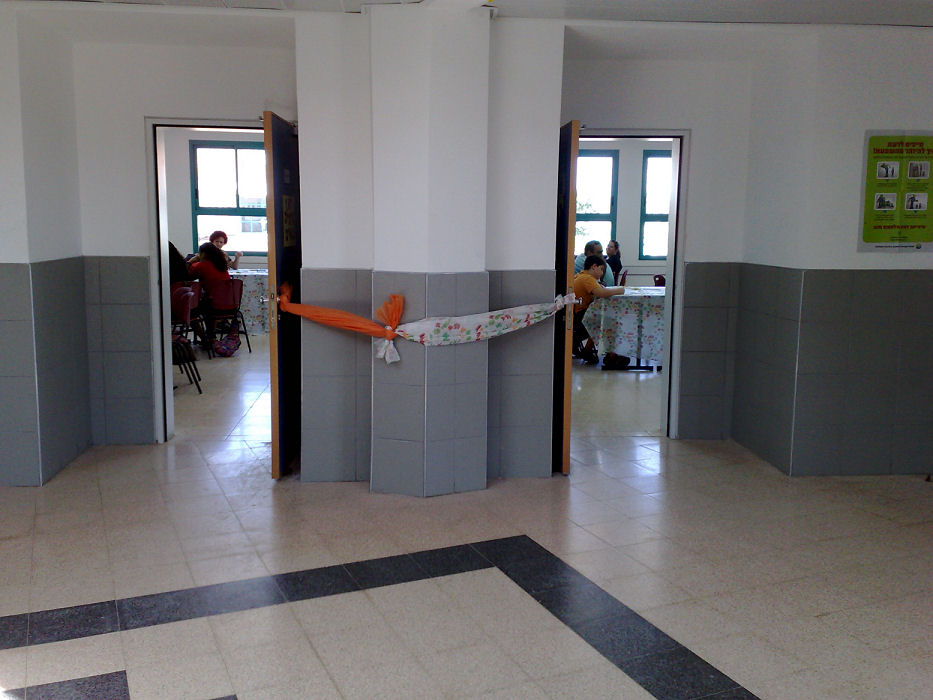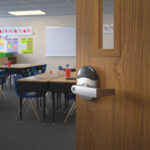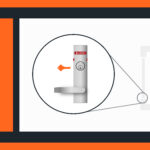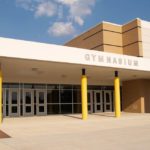Questions about door closers on classroom doors have been coming up frequently, so I have updated this Decoded article to reflect the current code requirements. What are you seeing in the field? Closers, or no closers?
This post was published in Doors & Hardware

 Prior to the widespread use of automatic fire sprinkler systems in schools, the doors between the corridors and classrooms were often fire doors – typically 20-minute rated. Because fire doors must be closed if a fire occurs in order to deter the spread of smoke and flames, they are required to be self-closing, automatic-closing, or power operated. When classroom doors are self-closing, it is not uncommon to see the doors propped open for convenience, which defeats the purpose of a self-closing fire door.
Prior to the widespread use of automatic fire sprinkler systems in schools, the doors between the corridors and classrooms were often fire doors – typically 20-minute rated. Because fire doors must be closed if a fire occurs in order to deter the spread of smoke and flames, they are required to be self-closing, automatic-closing, or power operated. When classroom doors are self-closing, it is not uncommon to see the doors propped open for convenience, which defeats the purpose of a self-closing fire door.
The International Building Code (IBC) does not require fire rated corridor walls in Group E (educational) occupancies that are equipped throughout with an automatic sprinkler system, so fire door assemblies are not typically required by the IBC for classroom doors. If the doors are not fire doors, door closers are not mandated by code, although some classrooms have self-closing doors for security purposes.
The applicable requirement in NFPA 101 – Life Safety Code was a bit harder to track down. According to the 2021 edition of NFPA 101 (14.3.6), corridor walls in educational occupancies must have a 1-hour fire resistance rating in accordance with Section 8.3, with certain exceptions:
- If all of the classrooms have an egress door leading to the outside or to an exterior exit access, the interior corridor walls are not required to be fire rated.
- In fully-sprinklered educational buildings, fire rated corridor walls are not mandated, but the walls must be smoke partitions – which would require self-closing or automatic-closing doors.
- If the corridor ceiling is an assembly with a 1-hour rated fire resistance rating where tested at a wall, the walls can terminate at the corridor ceiling.
- Lavatories do not require a 1-hour separation from the corridor, as long as there are 1-hour walls between the bathrooms and other spaces.
- In fully-sprinklered buildings, bathrooms don’t require a 1-hour separation if the walls separating the lavatory from other rooms are smoke partitions.
Where the Life Safety Code requires school corridor walls to have a 1-hour fire resistance rating or to be constructed as smoke partitions, the doors would have to be self-closing, automatic-closing, or power-operated. However, there is an exception in NFPA 101 Section 14.3.6(2)(b), that says, “The provisions of 8.4.3.5 shall not apply to normally occupied classrooms.” If you’re skimming too fast, you could pass right over this reference to Section 8.4.3.5, which is the section that says the doors have to be self-closing or automatic-closing. By exempting normally occupied classrooms from the requirement for self-closing/automatic-closing doors, recent editions of the Life Safety Code do not mandate closers on classroom doors. The same exemption appears in the chapter for existing educational occupancies, which differs slightly because instead of 1-hour walls, walls with a 1/2-hour rating are required.
One question remains – which classrooms are “normally occupied”? This term is not defined in NFPA 101, so it would be up to the authority having jurisdiction (AHJ) to decide whether a particular classroom meets the requirements for this exemption. My guess is that most classrooms in a school would be considered normally occupied. It’s important to note that existing schools will likely be subject to the codes that were in effect when the school was built or renovated. The exemption referencing door closers on normally occupied classrooms first appeared in the 2009 edition of the Life Safety Code. Keep in mind that the code that applies to your project may differ from the requirements discussed here, and the AHJ has the final say.
Photo courtesy of Eyal Bedrik of Entry Systems Ltd. Thanks again, Eyal!!
You need to login or register to bookmark/favorite this content.










Lori, on non rated classrooms I highly recommended to the end user we provide closers to control the doors. We’d normally use a Cush and hold, delete the stop in the closer mounting plate, add a LCN filler for where the stop came out of and used a wall stop. This gave the end user control of the door as well as a hold open that could be manually turned on or off. BHS has supplied thousands of these closers over the years. Controls the noise when door closes as well as the danger of a heavy door hitting someone in the opening or closing cycle.
Thanks for sharing your insight, Bob!
– Lori
In regard to NFPA 101, 2018 Ed or newer, the section before 14.3.6 for corridors, is a sprinkler requirement in 14.3.5, requiring any new construction over 2 classrooms or 1000 SF to be sprinkled. This almost defaults the typical corridors in new construction to be a smoke partition by default.
Additional NFPA 101 requirements in 14.3.2.1 (2) in a sprinkled K-12 are required to have 1-hour ratings in what a majority of AHJ’s classify as vocational, and/or STEM learning suites. Some additional classroom areas that might have corridor classroom/learning areas w/ 1-hour rated suites/rooms are high school level science labs, dramas with large scenery and costume storage, or any music or drama classroom opening on to a stage under Section 12 Assemblies.
Thanks Laura! I appreciate this additional info!
– Lori